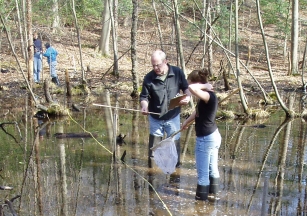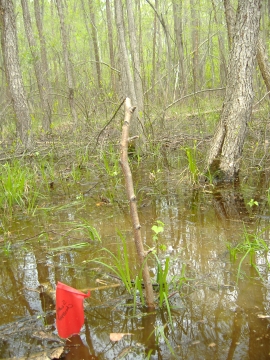Protocol for Monitoring Larger Vernal Pools
Monitoring methodology developed by Jeffrey Campbell and presented at the Maryland Water Monitoring Council Vernal/Seasonal Pool Workshop in 2008.
Monitoring Protocol for Larger Vernal Pools
Jeffrey D. Campbell1,
Lindsay Hollister2, Elaine Friebele2
1Center
for Urban Environmental Research and Education, UMBC
2Jug Bay Wetlands Sanctuary
Abstract
Unlike smaller vernal pools where most of the water surface is easily visible from the shoreline, larger pools require a different monitoring procedure. The methodology developed to study a vernal pool with maximum extent of 1.3 ha is described. The research objective is to support long term monitoring of obligate and facultative species populations. Egg mass count is of particular interest.
Egg masses are counted along randomly defined transects across the pool. Periodic dip net samples with a 1 meter sweep are taken to capture adult and larval amphibians and invertebrates. Physical properties of the pool (dimensions, pH, dissolved oxygen, temperature, salinity, turbidity) and weather (temperature, sky conditions affecting visibility) are also recorded.
The double observer technique is used to obtain a statistical measure for errors in egg mass counting. The observers follow transects identified with ropes marked at one meter intervals with poles every five meters. Egg mass counts are recorded for each square meter. The water depth is measured at each pole. One objective of measuring depth is to quantify the anecdotal relationship between depth and spotted salamander (Ambystoma maculatum) egg masses. The measurements will also allow a depth-weighted estimate of total pool population. The size of the vernal pool is obtained by measuring the distance along the transects and by recording the dimensions with a GPS while walking around the perimeter.
Poster and Other Materials

- The poster (pdf file, large paper size) describes the design and rationale for the new research techniques developed to survey populations in large vernal pools.
- The project summary was written to give the volunteers who would conduct the survey an introduction to the research methodology and detailed instructions for performing the study.
- There are two data sheets. The "Survey Data" sheet includes general characteristics of the site, weather conditions and water quality. The "Transect Data" sheet is a two sided form used to record the count of egg masses and larvae found while following each transect across the pool. This form is computer generated to include only the observation points that are currently within the pool. (Since the size of the pool varies over time, the transects were defined to cover the maximum extent of the pool.). There is also the version of the "Transect Data sheet" with an explanation of usage that was presented along with the poster at the workshop.
Subsequent Results
Since the protocol was developed and transects marked in 2008, field conditions have been variable. For two consecutive years, the vernal pool did not contain any water during the wood frog and spotted salamander breeding season. In two other years, the water levels in the pool were so high (a maximum of almost a meter deep) that the tannic water color, algae, and surface particulates made observation of egg masses unreliable. In essence the Secchi depth was far less than the water depth so only a part of the water column was observable. The dip net sweeps for larvae were also less effective since the size of the dip net was no longer comparable with the water depth. As a result, the defined net sweep would miss any larvae at a different depth; a condition not anticipated when the protocol was first prepared.
Volunteer interest in surveying this vernal pool has waned, so a "deep water" revision to the protocol has not yet been developed. It is expected that the protocol will be field tested again in the future under more typical pool conditions.
References
Grant, E.H.C., et al., " Double-observer approach to estimating egg mass abundance of pool-breeding amphibians," Wetlands Ecology and Management, 2005. 13: p. 305-320

